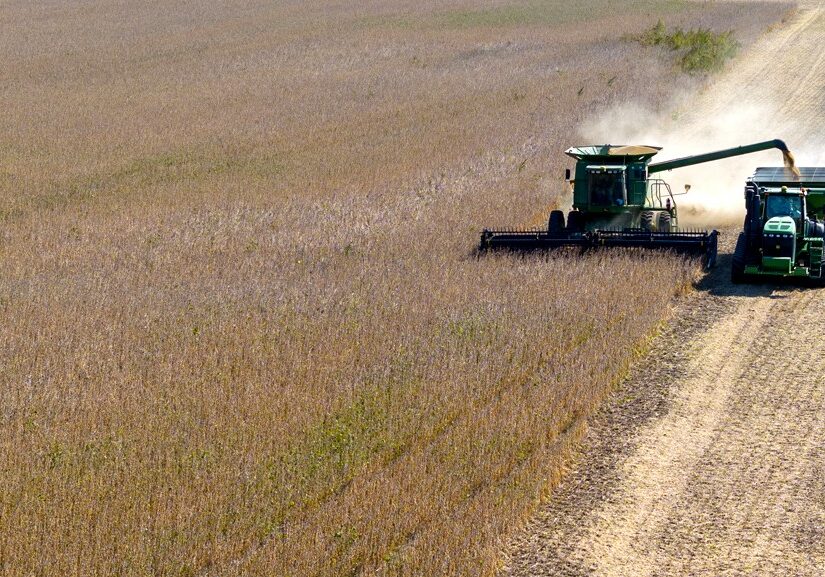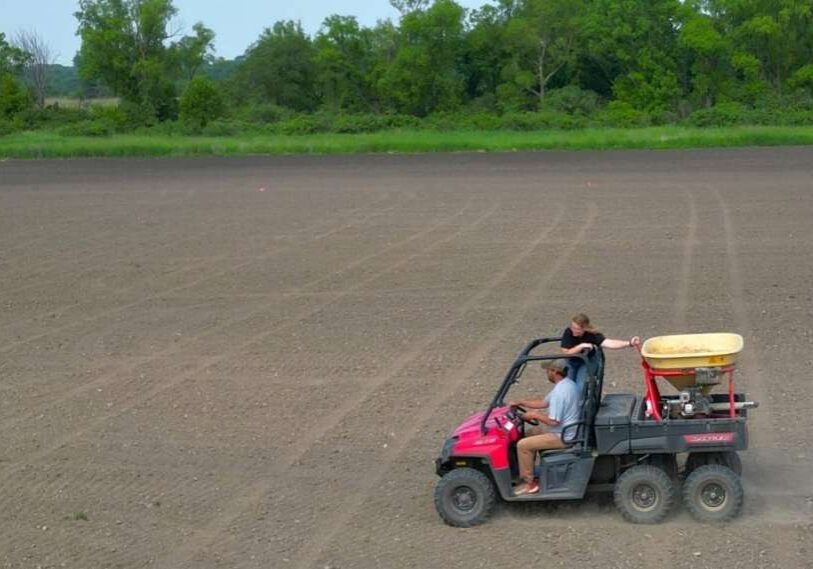Upper Mississippi National Wildlife Refuge Turns 100

WINONA — Around 10 a.m. on January 27th, Winona area youths and adults from 17 families walked, often hesitantly, onto the Mississippi River ice at Winona’s McNally Landing so the youngsters could learn to ice fish.
Waiting on the ice were members of the Upper Mississippi River National Wildlife and Fish Refuge staff and volunteers who had drilled holes and were ready with jigging rods, bait and advice. In the next two hours, Carter Schneider, 11, of Winona, with help from his grandfather, Al Schneider, would catch two sunfish.
By catching standards, it was slow. But all the youths got to ice fish, often for the first time, and they spent time outdoors.
Something else was special about the annual learn-to-fish day—it was the first event in the year-long celebration of the refuge’s 100th anniversary. Because of the refuge, these kids had a river backwater to walk onto and fish. That, in turn, was because 101 years ago, Will Dilg from Chicago, had a great idea.
Dilg was a member of the Izaak Walton League of America that he helped found the year before—and he loved to fish smallmouth bass on the Mississippi. But he was also aware of a dramatic change proposed for the river from Wabasha, south into Iowa—a plan to build dikes along the river and drain water from behind them to turn into farmland.

Will Dilg, who helped found the Izaak Walton League of America, was instrumental in getting the Upper Mississippi River National Wildlife and Fish Refugee created 100 years ago. (Izaak Walton League of America photo)
Dilg was incensed. Ikes, as Izaak Walton members referred to themselves, called it “The Drainage Crime of the Century.” But he was also a visionary.
As the story goes, he was fishing on the river, possibly in the Winona area, when it hit him: “We can make this whole cockeyed territory into a fish and game refuge.”
Fish and game refuges were relatively new, with the first one, Pelican Island National Refuge in Florida, authorized 19 years earlier.
Dilg was not one to sit idle. Somehow, he managed to talk with President Coolidge in the Oval Office and pitched the idea. The president liked it. Congress approved it and in 1924, the Upper Miss, as it’s usually known, was formed.
The Refuge Takes Shape
It took a while to get the land for the Upper Mississippi River National Wildlife and Fish Refuge that now stretches 261 miles along the Mississippi from Wabasha to Rock Island, Ill.
It began small and gradually grew, and grew, and grew until it’s now 240,000 acres. (The refuge, running adjacent to southeast Minnesota’s Houston County, can be seen in these two maps: the northern portion, from La Crescent to just north of Brownsville–including the confluence with the Root River–and the southern portion from Brownsville to the Iowa border.)
It’s a major refuge because its land is the most productive fish and wildlife habitat of the river from the Twin Cities to the Gulf of Mexico. The Mississippi Flyway is one of four major bird migration highways of North America and the most important.
The U.S. Fish and Wildlife Service (USFWS) which manages the refuge, said “Over 290 species of birds migrate through the refuge across its 240,000 acre stretch, utilizing the bottomland forest, marshland, river, and prairie ecosystems on their journeys.”

A mother and her daughter work on catching fish through the ice during a learn-to-fish event on a Mississippi River backwater near Winona. It was the first of many events that will be held during the celebration of the 100th anniversary of the Upper Mississippi National Wildlife and Fish Refuge.
History of the Upper Miss

There are thousands of signs like this along the Mississippi River in Minnesota, Wisconsin, Iowa, and Illinois delineating the Upper Mississippi National Wildlife and Fish Refuge.
Over the century, huge changes happened on the Upper Miss, the biggest being the nine-foot channel. Before Europeans came to the river in larger numbers in the early- to mid-1800s, the river was a series of braided channels that changed with the season and the years. Each year, flooding would bring sediment into lands along the river; once flooded, those lowlands provide spawning habitat for fish and places for wildlife.
In summer, the lowlands would usually dry out and farmers would sometimes go out and cut hay there. The lower water of summer also meant mudflats got air and sunlight, allowing them to blossom with precious vegetation that might flood in fall rises or spring floods. The river, which was slowly rising, perpetually renewed itself and its channels.
That didn’t work well for the settlers, however, because it was too shallow when they needed to get steamboats up to bring in more people and materials for more cities, and downriver to bring produce to markets.
Congress approved a series of wing dams, which are long thin rock structures jutting perpendicular from shore, to force the river to concentrate its current and essentially dredge itself. The 4.5-foot channel wasn’t enough in times of drought so a 6-foot channel was approved, with more wing dams and with more hopes for a river that would serve humans.
Still not enough. In the early 20th century, commercial interests in the Upper Midwest lobbied Congress to build a series of locks and dams on the river, allowing large towboats to move barges, no matter how low the river got because the main channel would always be at least 9 feet deep. Most were built in the early 1930s. (Learn more…read our story on The Mighty Mississippi’s Locks and Dams—What and Why?)
These locks and dams also brought massive changes to the Upper Miss. Its lowlands, that once flooded and then dried, were turned into river backwaters. At first, they were a huge benefit to fish and wildlife. But over the decades, they slowly aged.
Now, the USFWS, along with the Corps of Engineers that operates the locks and dams, as well as state natural resource agencies, are trying to not necessarily turn back the aging clock but at least slow it with special islands that create habitat and slow the wind so it doesn’t roil and muddy water. With clearer water comes more vegetation. If the flow is just right, they also lower the channel a bit to expose more mudflats.
Kids catching fish

Willa Tillinghast, 6, of Winona, tries ice fishing for the first time.
Such changes were not on the minds of those who walked onto the thawing ice January 27th at McNally Landing. If fact, many didn’t even know they were on a national wildlife and fish refuge.
Carter Schneider, the boy who caught two fish, for example, said he had no idea he was on a refuge nor what it’s for. But a sign did tell him Upper Miss is 100 years old. He did know how his grandfather’s Vexilar fishfinder worked.
“We could see the fish coming towards it,” he said right before he reeled in his second bluegill. “It looked like another red mark.”
His grandfather said he was aware the backwater was part of the refuge. “We fish here a lot of times in the summer,” he said. “I’ve never ice fished out here though. This is excellent, you can’t beat this; I don’t utilize it as much as I should.”
Nearby, Nathan Tillinghast was on the ice with his two children and wife. He is very aware that he was on refuge land because he’s the federal wildlife officer who patrols the refuge.
How many people on the refuge know they’re on a refuge varies with seasons, he said. In fall, with duck hunting, about 80 percent of hunters are aware because they have to know regulations about who can hunt and where.

Carter Schneider, 11, of Winona reels in a nice sunfish from a Mississippi River backwater near Winona January 27. Helping are, at left, his grandfather, Al Schneider and USFWS biologist Steve Winter.
In summer, most boaters “don’t have any idea about the refuge,” he said. “They think they are on a sunny beach on the Mississippi River.” Maybe half of summer recreationists know, he said.
And then Natalie Vogel-Gabor, 5, came to fish with maybe a half hour remaining in the two-hour event. Her mother, Jennifer Vogel, said she had never ice fished but knew she was on a refuge that is a major flyway.
“We’re trying to get her to do more outdoorsy stuff,” Vogel said. The refuge is an ideal place to do it. “You don’t have to worry you’re not on someone else’s land,” she said.
That’s the kind of things Jennie Froehly, a refuge wildlife biologist, likes to hear.
Froehly knows many users aren’t aware of the refuge but being used for recreation is one of its purposes, she said as she was leaving the ice with most of the families, staff and volunteers.
Behind her was Natalie, the last youth off.
Number of fish? “Zero,” she said. But she added she had “100 percent fun.”
To learn more about 2024’s Upper Mississippi River National Wildlife and Fish Refuge centennial events, visit its First 100 Years website. The Winona Arts Center is hosting the world premiere of the Riverlorian Productions film “A Visit from Will Dilg”, Saturday, May 4, at 7 p.m. The film honors the man Big River Magazine describes as “…the visionary who pushed Congress for the creation of the Refuge.” Area performer Steven Marking portrays Will Dilg in the film–he has been sharing Dilg’s story in performances this year that includes stories and songs about the river. Other events in this region include: Volunteer-led canoe paddles through the refuge will be held this summer.






